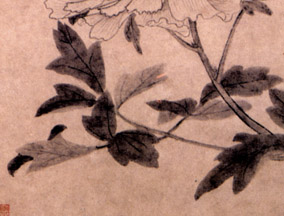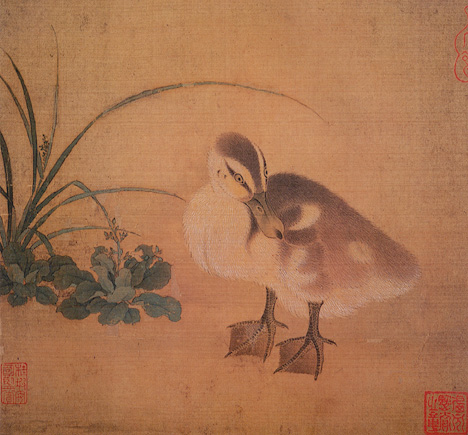| When the founding emperors of the Song defeated the courts of their
rivals, they took over their court artists, who included some experts in
bird and flower painting. From then on, this type of painting was
a specialty of the court. |
 This large
handscroll, perhaps originally part of a screen painting, was painted by
Cui Bo, active during the reign of Shenzong (r. 1067-85). This large
handscroll, perhaps originally part of a screen painting, was painted by
Cui Bo, active during the reign of Shenzong (r. 1067-85).
What is happening in this painting?
Can you tell what season it is?
Click here for details.
[In the guide, below]
|
|
Cui Bo, Magpies and Hare
|
|
SOURCE:
Cui Bo, Magpies and Hare, from Guoli gogong bowuyuan, ed. Qianxi
nian Wongdai wenwu dazhan (Taibei: Gogong, 2000), pp. 116-7. Collection
of the National Palace Museum, Taibei. Hanging
scroll on silk, 193.7 by 103.4 cm.
|
|
|
| MORE:
Cui Bo, like many other painters from the provinces, came to the
capital to seek an appointment at court. Known as a genius
at painting but otherwise eccentric and inept at practical
matters, the emperor Shenzong required very little of him other
than to paint for him personally.
This painting has the
title "Double Happiness," a reference to the
pronunciation of the Chinese word for magpie. "Two
magpies" was pronounced the same as "two
happinesses," so a painting of two magpies was a pictorial
metaphor for double happiness and thus an appropriate subject
for a painting to be given to someone to express
congratulations, especially for a wedding. In many other
cases as well paintings of birds and flowers gain meaning from
homophones of the objects depicted.
The painting is signed
and dated 1061, making it the earliest such signed and dated
painting. |
|
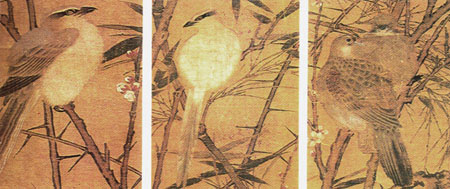 The birds and branches
shown here are details from a large hanging scroll, depicting several
birds perched in the branches of an old plum tree or the bamboo next to
it. The painting was probably done by artists serving under Huizong (r.
1100-1125). The birds and branches
shown here are details from a large hanging scroll, depicting several
birds perched in the branches of an old plum tree or the bamboo next to
it. The painting was probably done by artists serving under Huizong (r.
1100-1125).
To see the entire scroll, click here.
[In the guide, below]
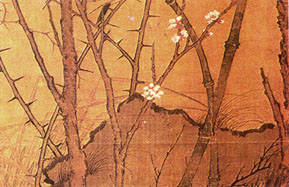 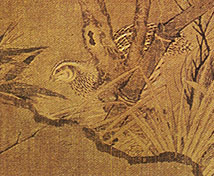
|
| SOURCE:
Lin Boting, "Songren meizhu quqin tu," Gugong wenwu
yuekan 1 (1983), pp. 74-78. |
|

Another detail:

|
|
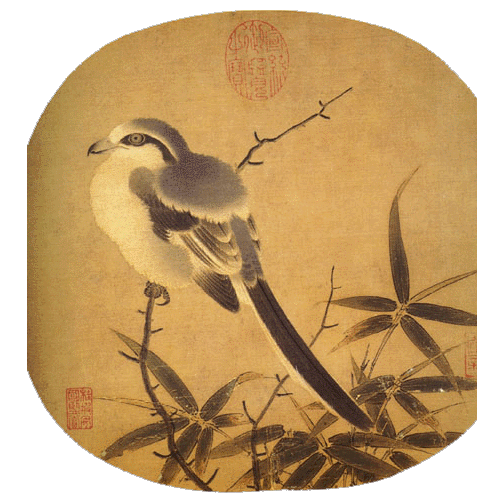
Very similar painting techniques were used by Li Anzhong, a court
artist who began painting in the late Northern Song court but joined the
Southern Song court as well after it relocated in Hangzhou.
Would you be able to identify this bird from the way it is depicted? |
|
Li Anzhong, "Bird on Branch"
|
|
SOURCE:
Li Anzhong, “Bird on a Branch,” from Qin Xiaoyi, ed., Songdai
shuhua ceye mingpin tezhan - Famous Album Leaves of the
Sung Dynasty (Taipei: Guoli gugong bowuyuan pianzhuan
weiyuanhui, 1995), pl. 57.
Collection of the National Palace Museum, Taibei. Album
leaf on silk, 25.4 by 26.9 cm.
|
|
|
|
Throughout the Southern Song exacting depiction of nature
was appreciated at court. |
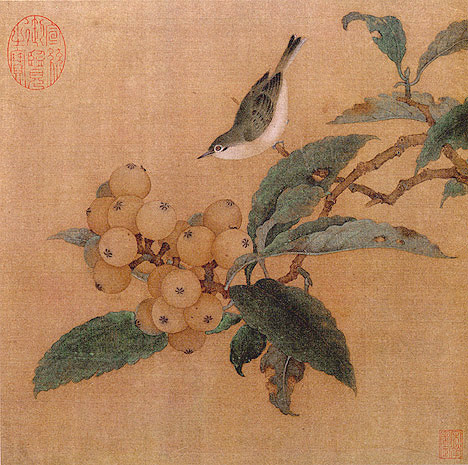 |
|
Anonymous Southern Song artist, Loquats
and Mountain Bird
| SOURCE:
Fu Sinian, ed., Zhongguo meishu quanji, huihua bian 4: Liang
Song huihua, xia (Beijing: Wenwu chubanshe, 1988), pl. 96, p.
131. Collection of the National Palace Museum, Beijing. Album leaf, colors on silk, 28.9 x 29 cm |
|


